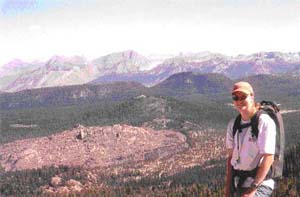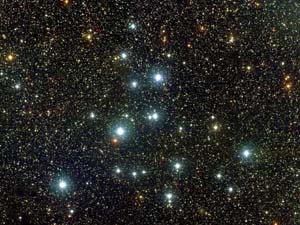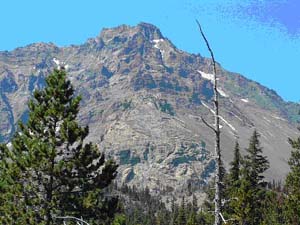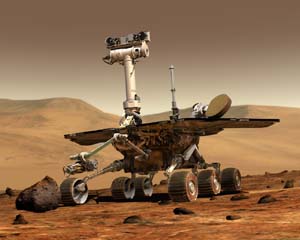Cosmic Rocks and Astronauts
 My name is
Celestine Mercer and I’m a graduate student in the
Department of Geological Sciences at the University of
Oregon in Eugene, Oregon, USA. When I was a little girl,
I loved to look at the stars!
My name is
Celestine Mercer and I’m a graduate student in the
Department of Geological Sciences at the University of
Oregon in Eugene, Oregon, USA. When I was a little girl,
I loved to look at the stars!
I lived on a farm in Colorado where the skies were dark
and the stars were very bright. When I was in high
school, I decided to sell my cows so that I could
purchase a telescope that would allow me to study the
stars more closely. With a telescope I could see craters
on the Moon, Mars’ red color, Saturn’s rings,
Jupiter’s moons, newly formed stars, cosmic dust
clouds, and even other galaxies! But observing these
celestial objects just
 made me more curious about them... Why do
they move the way they do? How did they form? I wanted
to go to one of the planets and look around! I wanted to
be an astronaut!
made me more curious about them... Why do
they move the way they do? How did they form? I wanted
to go to one of the planets and look around! I wanted to
be an astronaut!
I studied very hard in high school and earned an
academic/athletic scholarship to attend Oberlin College.
At Oberlin I studied physics, math, astronomy, chemistry,
and geology. Planetary geology and
“mineralogy” (the study of crystals) were my
favorite classes. College was fun and provided me with
an overload of interesting information! Did you know
that Mars has the biggest volcano and deepest canyon in
the solar system? Did you know that there are oceans
covered in thick ice on Jupiter’s moon, Europa,
which could contain life? Did you know there are
continually erupting volcanoes on Jupiter’s moon,
Io, because the competing gravity of the Sun and Jupiter
are tearing Io apart? Did you know that your bicycle
would melt on Venus because a runaway greenhouse effect
makes it very hot there? Did you know that scientists
made a spacecraft that flew by a comet, stuck its little
robotic arm out to catch comet dust, and is now flying
back to Earth to return the exotic space dust? Wow!
After learning these things, I decided that I wanted to
study the geology of nearby astronomical objects like the
planets and moons of our solar system. Besides, one of
the first people to walk on Mars would need to be very
knowledgeable about these things!
After my third year of college I interned at the Jet
Propulsion Laboratory. (The Jet Propulsion Laboratory
makes all kinds of amazing spacecrafts, Mars rovers, and
gadgets for the space shuttles. They study the
information these space crafts return as well.) There I
helped a real planetary scientist map uncharted
territories on Venus and search for evidence of water on
Mars!
During my last year of college, I had the opportunity to
help a real volcanologist study recently erupted
volcanoes in California. I worked “out in the
field” collecting rocks that had exploded out of
the volcanoes and lava samples that flowed from the
volcanoes. Then I took the samples back to my college to
study them with a microscope and try to understand how
the volcano erupted. Pretty amazing that rocks could
tell such an interesting story, huh? Understanding how
and why volcanoes erupt is very important because active
volcanoes can be very dangerous to people and animals.
(Volcanoes can also be very helpful for people and
animals because they make soil rich for growing grass and
crops.)
After I graduated from college I decided that I wanted to
continue studying science and get my PhD. But which
fascinating topic did I want to study? One day I was
watching a video about the 1991 eruption of Mt. Pinatubo
in the Philippines when I got the goose bumps from the
excitement! Volcanic eruptions are very amazing because
they are an incredible force of nature that no one on
Earth can control. When a volcano decides it’s
ready to erupt, watch out! So I decided that I would
study volcanoes since there are many to observe on Earth
as well as in space.
 Now I am at the University of Oregon studying a Cascade
volcano in central Oregon named North Sister.
You may hear about it in the news because
its neighboring volcano, South Sister, is becoming
restless and may erupt sometime soon! I am becoming an
“experimental petrologist”, or a “rock
detective”. I study the crystals and textures in
volcanic rocks which contain evidence of the rock’s
long journey through the Earth. Understanding a
rock’s journey can help predict how violently it
will erupt from a volcano so that we can warn people who
may live nearby. In my laboratory I melt volcanic rocks
under enormous pressures. This simulates the conditions
that magma experiences as it moves its way through the
Earth’s mantle and crust to a volcano. By studying
the minerals that form at many different pressures and
temperatures, I can piece together a history of the
volcanic rocks that I picked up at North Sister! The
oven in my lab heats up to 1400°Celsius which is
about 5 times hotter than your oven at home! The
“piston-cylinders” in my lab press with
enough force to pick up eight houses at once, and they
simulate being inside the Earth up to 60 miles beneath
your feet! Here’s how I run an experiment:
(Don’t try this at home!)
Now I am at the University of Oregon studying a Cascade
volcano in central Oregon named North Sister.
You may hear about it in the news because
its neighboring volcano, South Sister, is becoming
restless and may erupt sometime soon! I am becoming an
“experimental petrologist”, or a “rock
detective”. I study the crystals and textures in
volcanic rocks which contain evidence of the rock’s
long journey through the Earth. Understanding a
rock’s journey can help predict how violently it
will erupt from a volcano so that we can warn people who
may live nearby. In my laboratory I melt volcanic rocks
under enormous pressures. This simulates the conditions
that magma experiences as it moves its way through the
Earth’s mantle and crust to a volcano. By studying
the minerals that form at many different pressures and
temperatures, I can piece together a history of the
volcanic rocks that I picked up at North Sister! The
oven in my lab heats up to 1400°Celsius which is
about 5 times hotter than your oven at home! The
“piston-cylinders” in my lab press with
enough force to pick up eight houses at once, and they
simulate being inside the Earth up to 60 miles beneath
your feet! Here’s how I run an experiment:
(Don’t try this at home!)
-
Collect a rock from a volcano and grind it into a
powder
-
Fill a little “soda-can” the size of your
pinky fingernail with the rock powder and weld the can
shut; this can is made of special material (platinum or
palladium) that will not melt at 1400°C
-
Place the soda can inside a custom-made
“furnace”; this furnace is made out of
graphite (the mineral in your pencil) and heats up when
I pass an electrical current through it
-
Place the furnace/soda-can assembly into the center of
the “bomb”; the bomb is a disk made out of
steel and tungsten carbide- very strong stuff; this
keeps my rock sample from squishing like a pancake when
I apply pressure to it
-
Place the bomb into the “piston-cylinder”
apparatus and squeeze the sample!
-
Turn on cooling water (so I don’t burn the lab
down!) and turn on electricity to heat the sample; the
rock sample is now melted and white hot (like a baby
magma chamber)!
-
Now my rock sample is at the Earth’s
“mantle” or “crust”, depending
on how hard the piston-cylinder is squeezing!
I usually leave the rock sample there for a day so that
all of the crystal growth and slow chemical processes
have a chance to do their magic… When I
“quench” (chill) and decompress the sample,
the soda-can is squished and the rock inside is now a
beautiful green glass with crystals. Then I use many
different techniques, such as shooting electrons at the
rock or passing infrared radiation thru it, to study the
glass and crystals that I have made.
Now, what do crystals have to do with being an
astronaut? Well, understanding crystals and rocks and
volcanoes on Earth is the first step to understanding
them on the Moon, Mars, or the other planets. Much of
our understanding of the Moon has come from studying
rocks that Apollo astronauts brought back to Earth i
n the 1970s. The rocks on the Moon are
not like the rocks you and I see everyday. They are more
like the rocks that are deep down in the mantle of the
Earth.
 This knowledge has helped scientists create a
theory of how the moon was created. Have you ever hiked
up a mountain on Earth? Well, try it on Mars! Mars has
the tallest volcano in the solar system, Olympus Mons,
which is more than three times as tall as Mt. Everest!
Mountains on Mars can reach taller heights because the
gravity of Mars is less than half that on Earth. The
Mars Rovers, Opportunity and Spirit, are tromping around
Mars right now probing the rocks and dust on the Martian
surface. The goals of these “robotic
geologists” are to characterize the climate and
geology of Mars, determine whether life ever arose on
Mars, and prepare for human exploration. And who knows,
I bet one of the first human Martian explorers will be a
geologist! I hope so! Maybe you could be a Martian
explorer too!
This knowledge has helped scientists create a
theory of how the moon was created. Have you ever hiked
up a mountain on Earth? Well, try it on Mars! Mars has
the tallest volcano in the solar system, Olympus Mons,
which is more than three times as tall as Mt. Everest!
Mountains on Mars can reach taller heights because the
gravity of Mars is less than half that on Earth. The
Mars Rovers, Opportunity and Spirit, are tromping around
Mars right now probing the rocks and dust on the Martian
surface. The goals of these “robotic
geologists” are to characterize the climate and
geology of Mars, determine whether life ever arose on
Mars, and prepare for human exploration. And who knows,
I bet one of the first human Martian explorers will be a
geologist! I hope so! Maybe you could be a Martian
explorer too!
Astronauts can have many different professions.
Astronauts can be astro-geologists, astronomers,
physicists, computer scientists, biologists, doctors,
meteorologists, engineers, chemists, nutritionists,
airplane pilots, and teachers just to name a few! So no
matter where your interests lie, if you really want to be
an astronaut, don’t be afraid to make a leap for
your dreams!
"That's one small step for man, one giant leap for
mankind."
Neil Armstrong
First astronaut to land on the moon in 1969
Here are some fun links:
How to Become and Astronaut:
http://nasajobs.nasa.gov/astronauts/
Astronaut Biographies: See where the astronauts
started out; Roberta L. Bondar is the first Canadian
Woman in Space!
http://www.jsc.nasa.gov/Bios/
Interactive Astronaut Information: Living in Space,
Astronaut School, Meet the Astronauts
http://edspace.nasa.gov/index.html
Mineralogy for Kids: Minerals in Your House, Mineral
Properties, Crystals, Games
http://www.minsocam.org/MSA/K12/K_12.html
NASA Kids: Astronaut and Space Fun Facts, Space
Pictures, Interactive Games
http://www.nasa.gov/audience/forkids/home/index.html
Jet Propulsion Laboratory Kids: Galaxy Games, Learn
about Mars, Robotics, Math Activities
http://www.jpl.nasa.gov/kids/
USGS Kids: Trivia, Make Models of Volcanoes, Earth
Quakes, Homework Help, Term Glossary, Projects
http://interactive2.usgs.gov/learningweb/students/index.htm
Mars Rover Updates: See What Spirit and Opportunity
Did Today!
http://marsrovers.jpl.nasa.gov/home/
Astronomy Picture of the Day: Beautiful Pictures of
Earth, the Planets, and Our Universe
http://antwrp.gsfc.nasa.gov/apod/astropix.html
Open Cluster of Stars
Space Walk
Spirit Rover Working Hard on Mars
Me studying a 500 year old lava flow in the Inyo Volcanic
Chain, Eastern California
1991 Eruption of Mt. Pinatubo, Philippines
North Sister Volcano, Cascades, Central Oregon
Piston-Cylinder Squeezing a Melted Rock Sample
Microscopic View of a Moon Rock